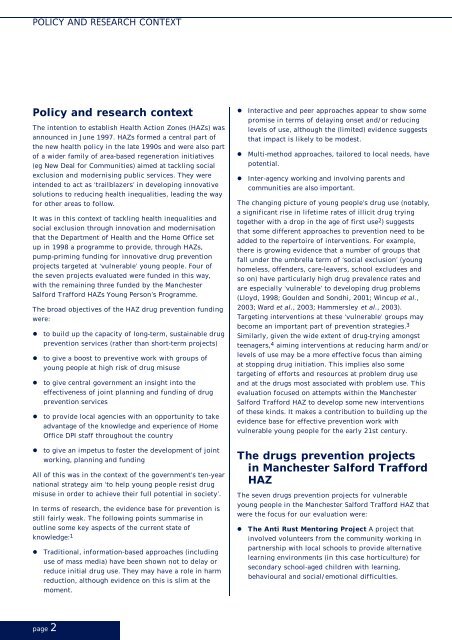Drug prevention for vulnerable young people - Nacro
Drug prevention for vulnerable young people - Nacro
Drug prevention for vulnerable young people - Nacro
Create successful ePaper yourself
Turn your PDF publications into a flip-book with our unique Google optimized e-Paper software.
POLICY AND RESEARCH CONTEXTPolicy and research contextThe intention to establish Health Action Zones (HAZs) wasannounced in June 1997. HAZs <strong>for</strong>med a central part ofthe new health policy in the late 1990s and were also partof a wider family of area-based regeneration initiatives(eg New Deal <strong>for</strong> Communities) aimed at tackling socialexclusion and modernising public services. They wereintended to act as ‘trailblazers’ in developing innovativesolutions to reducing health inequalities, leading the way<strong>for</strong> other areas to follow.It was in this context of tackling health inequalities andsocial exclusion through innovation and modernisationthat the Department of Health and the Home Office setup in 1998 a programme to provide, through HAZs,pump-priming funding <strong>for</strong> innovative drug <strong>prevention</strong>projects targeted at ‘<strong>vulnerable</strong>’ <strong>young</strong> <strong>people</strong>. Four ofthe seven projects evaluated were funded in this way,with the remaining three funded by the ManchesterSal<strong>for</strong>d Traf<strong>for</strong>d HAZs Young Person’s Programme.The broad objectives of the HAZ drug <strong>prevention</strong> fundingwere:• to build up the capacity of long-term, sustainable drug<strong>prevention</strong> services (rather than short-term projects)• to give a boost to preventive work with groups of<strong>young</strong> <strong>people</strong> at high risk of drug misuse• to give central government an insight into theeffectiveness of joint planning and funding of drug<strong>prevention</strong> services• to provide local agencies with an opportunity to takeadvantage of the knowledge and experience of HomeOffice DPI staff throughout the country• to give an impetus to foster the development of jointworking, planning and fundingAll of this was in the context of the government’s ten-yearnational strategy aim ‘to help <strong>young</strong> <strong>people</strong> resist drugmisuse in order to achieve their full potential in society’.In terms of research, the evidence base <strong>for</strong> <strong>prevention</strong> isstill fairly weak. The following points summarise inoutline some key aspects of the current state ofknowledge: 1• Traditional, in<strong>for</strong>mation-based approaches (includinguse of mass media) have been shown not to delay orreduce initial drug use. They may have a role in harmreduction, although evidence on this is slim at themoment.• Interactive and peer approaches appear to show somepromise in terms of delaying onset and/or reducinglevels of use, although the (limited) evidence suggeststhat impact is likely to be modest.• Multi-method approaches, tailored to local needs, havepotential.• Inter-agency working and involving parents andcommunities are also important.The changing picture of <strong>young</strong> <strong>people</strong>’s drug use (notably,a significant rise in lifetime rates of illicit drug tryingtogether with a drop in the age of first use 2 ) suggeststhat some different approaches to <strong>prevention</strong> need to beadded to the repertoire of interventions. For example,there is growing evidence that a number of groups thatfall under the umbrella term of ‘social exclusion’ (<strong>young</strong>homeless, offenders, care-leavers, school excludees andso on) have particularly high drug prevalence rates andare especially ‘<strong>vulnerable</strong>’ to developing drug problems(Lloyd, 1998; Goulden and Sondhi, 2001; Wincup et al.,2003; Ward et al., 2003; Hammersley et al., 2003).Targeting interventions at these ‘<strong>vulnerable</strong>’ groups maybecome an important part of <strong>prevention</strong> strategies. 3Similarly, given the wide extent of drug-trying amongstteenagers, 4 aiming interventions at reducing harm and/orlevels of use may be a more effective focus than aimingat stopping drug initiation. This implies also sometargeting of ef<strong>for</strong>ts and resources at problem drug useand at the drugs most associated with problem use. Thisevaluation focused on attempts within the ManchesterSal<strong>for</strong>d Traf<strong>for</strong>d HAZ to develop some new interventionsof these kinds. It makes a contribution to building up theevidence base <strong>for</strong> effective <strong>prevention</strong> work with<strong>vulnerable</strong> <strong>young</strong> <strong>people</strong> <strong>for</strong> the early 21st century.The drugs <strong>prevention</strong> projectsin Manchester Sal<strong>for</strong>d Traf<strong>for</strong>dHAZThe seven drugs <strong>prevention</strong> projects <strong>for</strong> <strong>vulnerable</strong><strong>young</strong> <strong>people</strong> in the Manchester Sal<strong>for</strong>d Traf<strong>for</strong>d HAZ thatwere the focus <strong>for</strong> our evaluation were:• The Anti Rust Mentoring Project A project thatinvolved volunteers from the community working inpartnership with local schools to provide alternativelearning environments (in this case horticulture) <strong>for</strong>secondary school-aged children with learning,behavioural and social/emotional difficulties.page 2
















